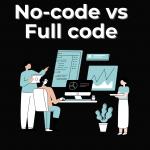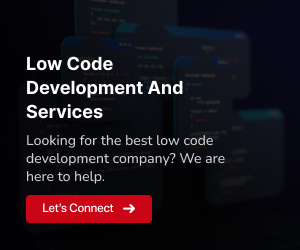What is a low-code development platform?
Did you know that the low-code market surged by 23 per cent since last year, generating profits of $11.3 billion? experts forecast a $13.8 billion expansion this year, potentially scaling to $30 billion within five years. This highlights the burgeoning prominence of low-code development platforms in enterprises. This empowers IT teams and developers to create a spectrum of applications, from streamlining workflows and modernizing legacy systems to automating data integration, facilitating data visualization, enhancing customer experiences, and crafting mobile apps.
The primary allure of low-code platforms lies in their ability to expedite app design and creation. Even developers with limited technical acumen can adeptly fashion applications faster than using native SDKs. Moreover, professional developers benefit from improved efficiency and cost-effectiveness in application creation due to digital transformation.
Engaging professional low-code development firms can also mitigate labour costs. If you seek a dependable enterprise low-code application platform, this article provides comprehensive insights into low-code development platforms and offers guidance on choosing the optimal solution.
How to choose a low-code platform?
Choosing the right low-code platform for your needs involves careful consideration of various factors to ensure it aligns with your organisation’s goals and requirements. Here’s a step-by-step guide to help you choose the most suitable low-code platform:
Define Your Requirements:
Start by identifying your specific needs and goals. Determine the types of applications you want to build, the complexity of these applications, and the specific features and integrations required. Begin by conducting an in-depth analysis of your organization’s specific requirements. Identify the scope of applications you intend to develop, considering their complexity, functionality, and intended user base. Whether you’re building customer-facing apps, internal process solutions, or data-driven tools, understanding your needs forms the foundation of your selection process.
Consider User Proficiency:
Assess the technical expertise of your team. Some low-code platforms are more suitable for experienced developers, while others are designed for citizen developers or non-technical users. Low-code platforms are celebrated for their accessibility. Evaluate the platform’s user interface, visual development tools, and the extent to which it reduces the learning curve for both technical and non-technical users. Intuitive features and user-friendly interfaces are crucial for maximum adoption and productivity.
Evaluate Ease of Use:
Test the platform’s user interface and workflow. It should be intuitive and easy to navigate, with drag-and-drop functionalities and clear documentation. A vibrant user community and robust customer support infrastructure are invaluable resources. Explore if the platform offers active forums, comprehensive documentation, educational resources, and responsive customer support channels.
Check Customisation Options:
Ensure the platform allows customization beyond the pre-built components. Look for the ability to add custom code when necessary for more advanced functionalities. While low-code platforms offer pre-built components, examine how much flexibility the platform affords for customization. Your applications should reflect your organization’s unique processes and branding. Look for the depth of customization in terms of design, functionality, and user experience.
Integration Capabilities:
Assess the platform’s integration capabilities. It should offer connectors or APIs to integrate with your existing systems, databases, and third-party services. The ability to integrate with existing systems, databases, and third-party applications is pivotal for a seamless technology ecosystem. Investigate the platform’s integration capabilities, including the support for APIs, connectors, and data synchronization. Smooth integration fosters a cohesive digital environment.
Scalability and Performance:
Consider the platform’s ability to handle increased usage and data as your application scales. Evaluate its performance and responsiveness under different loads. As your organization grows, your application demands will naturally expand. It’s imperative to ascertain whether the chosen platform can seamlessly scale to accommodate increased users, higher data volumes, and greater transaction loads. Scalability ensures that your applications remain responsive and efficient as your business evolves.
Security and Compliance:
Check if the platform provides security features such as encryption, user authentication, and role-based access controls. Verify that it meets compliance requirements for your industry. In an era of heightened data privacy concerns, security is paramount. Scrutinize the platform’s security features, encryption protocols, access controls, and compliance with industry regulations such as GDPR or HIPAA if applicable to your domain.
Vendor Reputation and Support:
Research the vendor’s reputation in the market. Read reviews, customer testimonials, and case studies to gauge customer satisfaction. Also, check the availability of customer support and resources. Research the vendor’s track record and industry reputation. Engage with user reviews, case studies, and testimonials to gauge their commitment to product excellence and customer satisfaction. An established and reputable vendor is indicative of a reliable partnership.
Cost Structure:
Understand the platform’s pricing model. Some charge based on users, and usage. Thoroughly assess the platform’s pricing structure. Compare subscription models, licensing fees, and any hidden costs related to support, hosting, and updates. Ensure that the pricing aligns with your budget and projected usage.
Deployment Options:
Check whether the platform supports the deployment options you need, such as web, mobile, or cloud-based applications. Anticipate how the chosen platform can accommodate emerging technologies like AI, machine learning, IoT, and others that might influence your industry’s landscape. Opt for a platform that positions your organization to embrace future advancements seamlessly.
Remember that the “best” low-code platform is the one that best fits your unique requirements and goals. It’s important to conduct thorough research, involve stakeholders, and perform due diligence before making a decision. Take your time to evaluate multiple options and seek input from your team members or colleagues who will be using the platform.

Best low-code platform in the USA?
Choosing the right low-code platform in the USA requires a systematic approach. Begin by defining your application needs and challenges. Assess your team’s technical proficiency and opt for a platform that matches their skill level. Look for user-friendly interfaces to ensure swift adoption. Prioritise flexibility for customisation, including coding for unique features. Seamless integration with existing systems, scalability for growth, and robust security measures are crucial. Vendor reputation, support responsiveness, and reviews provide insights into reliability. Understand the pricing model, deployment options, and potential vendor lock-in to budget accurately. Opt for a platform aligned with future technology trends for longevity. Evaluate suitability through trials or demos. Finally, confirm the platform’s capabilities with a small-scale project. Following these steps empowers you to confidently select the most suitable low-code platform for your USA-based organisation, meeting both present and future needs.
There are several reputable low-code platform vendors in the market. Keep in mind that the landscape may have changed since then, so it’s recommended to conduct up-to-date research and reviews to make an informed decision. Here are some notable low-code platform vendors:
OutSystems:
Known for its comprehensive features and rapid application development capabilities. Offers a wide range of integration options and supports mobile and web applications.
Appian:
Offers a unified low-code automation platform with strong process automation and integration capabilities. Suitable for both business and IT users.
Mendix:
Offers a user-friendly platform with a focus on collaboration between IT and business teams. Features strong app deployment and scaling options.
Salesforce Lightning Platform:
Provides a low-code environment within the Salesforce ecosystem. Great for businesses looking to extend their Salesforce functionality.
Microsoft Power Apps:
Part of the Microsoft Power Platform, it integrates well with Microsoft products and provides a user-friendly environment for building apps.
Kony (now part of Temenos):
Offers a platform for mobile and web app development with a strong focus on user experience and integration capabilities.
Zoho Creator:
Known for its ease of use and simplicity, suitable for small to medium-sized businesses.
Quick Base:
Offers a platform for building database-driven applications with a strong focus on automating workflows.
Betty Blocks:
Known for its user-friendly visual development environment and scalability.
Nintex:
Focuses on process automation and workflow management, offering low-code solutions for automating business processes.
AppSheet (Google Cloud):
Part of Google Cloud’s offerings, AppSheet focuses on mobile app development with data integration capabilities.
WaveMaker:
Offers a platform with a visual development environment for building responsive web and mobile applications.
These are just a few of the notable low-code platform vendors available. When selecting a platform, consider factors such as your organisation’s specific needs, ease of use, integration capabilities, scalability, and budget. Reading reviews, trying out demos, and consulting with your team can help you make the best choice for your organisation.
Conclusion
In conclusion, choosing the right low-code platform in the USA involves careful consideration of several factors. Defining application requirements, assessing team expertise, and prioritizing user-friendly interfaces are key starting points. Balancing customization, integration, and scalability ensures suitability for growth. Evaluating vendor reputation, support, and pricing aids budget-aligned decisions. By selecting a forward-looking platform and conducting trials, you confidently optimize USA operations. A well-informed choice unlocks low-code benefits, boosting efficiency, innovation, and success. GeekyAnts understands agile solutions for the dynamic US business landscape, empowering growth and innovation through expertise in platform selection.



















